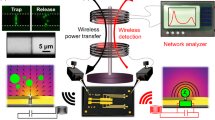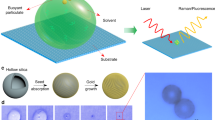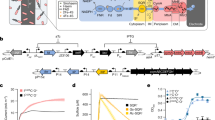Abstract
Biosensors can be miniaturized by either injecting smaller volumes into micro- and nanofluidic devices or immersing increasingly sophisticated particles known as ‘smart dust’ into the sample. The term ‘smart dust’ originally referred to cubic-millimetre wireless semiconducting sensor devices that could invisibly monitor the environment in buildings and public spaces1, but later it also came to include functional micrometre-sized porous silicon particles used to monitor yet smaller environments2,3. The principal challenge in designing smart dust biosensors is integrating transport functions with energy supply into the device. Here, we report a hybrid microdevice that is powered by ATP and relies on antibody-functionalized microtubules and kinesin motors to transport the target analyte into a detection region. The transport step replaces the wash step in traditional double-antibody sandwich assays. Owing to their small size and autonomous function, we envision that large numbers of such smart dust biosensors could be inserted into organisms or distributed into the environment for remote sensing.
This is a preview of subscription content, access via your institution
Access options
Subscribe to this journal
Receive 12 print issues and online access
$259.00 per year
only $21.58 per issue
Buy this article
- Purchase on Springer Link
- Instant access to full article PDF
Prices may be subject to local taxes which are calculated during checkout



Similar content being viewed by others
References
Kahn, J. M., Katz, R. H. & Pister, K. S. J. Emerging challenges: Mobile networking for ‘smart dust’. J. Commun. Netw. 2, 188–196 (2000).
Link, J. R. & Sailor, M. J. Smart dust: Self-assembling, self-orienting photonic crystals of porous Si. Proc. Natl Acad. Sci. USA 100, 10607–10610 (2003).
Sailor, M. J. & Link, J. R. ‘Smart dust’: nanostructured devices in a grain of sand. Chem. Commun. 1375–1383 (2005).
Soong, R. K. et al. Powering an inorganic nanodevice with a biomolecular motor. Science 290, 1555–1558 (2000).
Hiratsuka, Y., Tada, T., Oiwa, K., Kanayama, T. & Uyeda, T. Q. Controlling the direction of kinesin-driven microtubule movements along microlithographic tracks. Biophys. J. 81, 1555–1561 (2001).
Hess, H., Clemmens, J., Qin, D., Howard, J. & Vogel, V. Light-controlled molecular shuttles made from motor proteins carrying cargo on engineered surfaces. Nano Lett. 1, 235–239 (2001).
Nicolau, D. V., Suzuki, H., Mashiko, S., Taguchi, T. & Yoshikawa, S. Actin motion on microlithographically functionalized myosin surfaces and tracks. Biophys. J. 77, 1126–1134 (1999).
Bunk, R. et al. Towards a ‘nano-traffic’ system powered by molecular motors. Microelectron. Eng. 67–68, 899–904 (2003).
Hess, H., Bachand, G. D. & Vogel, V. Powering nanodevices with biomolecular motors. Chem. Eur. J. 10, 2110–2116 (2004).
van den Heuvel, M. G. L. & Dekker, C. Motor proteins at work for nanotechnology. Science 317, 333–336 (2007).
Dennis, J. R., Howard, J. & Vogel, V. Molecular shuttles: directed motion of microtubules along nanoscale kinesin tracks. Nanotechnology 10, 232–236 (1999).
Bachand, G. D., Rivera, S. B., Carroll-Portillo, A., Hess, H. & Bachand, M. Active capture and transport of virus particles using a biomolecular motor-driven, nanoscale antibody sandwich assay. Small 2, 381–385 (2006).
Ramachandran, S., Ernst, K.-H., Bachand, G. D., Vogel, V. & Hess, H. Selective loading of kinesin-powered molecular shuttles with protein cargo and its application to biosensing. Small 2, 330–334 (2006).
Diez, S. et al. Stretching and transporting DNA molecules using motor proteins. Nano Lett. 3, 1251–1254 (2003).
Taira, S. et al. Selective detection and transport of fully matched DNA by DNA-loaded microtubule and kinesin motor protein. Biotechnol. Bioeng. 95, 533–538 (2006).
Hirabayashi, M. et al. Malachite green-conjugated microtubules as mobile bioprobes selective for malachite green aptamers with capturing/releasing ability. Biotechnol. Bioeng. 94, 473–480 (2006).
Taira, S. et al. Loading and unloading of molecular cargo by DNA-conjugated microtubule. Biotechnol. Bioeng. 99, 734–739 (2008).
Lin, C.-T., Kao, M.-T., Kurabayashi, K. & Meyhofer, E. Self-contained, biomolecular motor-driven protein sorting and concentrating in an ultrasensitive microfluidic chip. Nano Lett. 8, 1041–1046 (2008).
Wu, D., Tucker, R. & Hess, H. Caged ATP: Fuel for bionanodevices. IEEE Trans. Adv. Packag. 28, 594–599 (2005).
Tucker, R., Katira, P. & Hess, H. Herding nanotransporters: Localized activation via release and sequestration of control molecules. Nano Lett. 8, 221–226 (2008).
Seetharam, R., Wada, Y., Ramachandran, S., Hess, H. & Satir, P. Long-term storage of bionanodevices by freezing and lyophilization. Lab. Chip 6, 1239–1242 (2006).
Uppalapati, M., Huang, Y. M., Jackson, T. N. & Hancock, W. O. Enhancing the stability of kinesin motors for microscale transport applications. Lab. Chip 8, 358–361 (2008).
Sheehan, P. E. & Whitman, L. J. Detection limits for nanoscale biosensors. Nano Lett. 5, 803–807 (2005).
Nitta, T., Tanahashi, A., Hirano, M. & Hess, H. Simulating molecular shuttle movements: Towards computer-aided design of nanoscale transport systems. Lab. Chip 6, 881–885 (2006).
Stracke, P., Bohm, K. J., Burgold, J., Schacht, H. J. & Unger, E. Physical and technical parameters determining the functioning of a kinesin-based cell-free motor system. Nanotechnology 11, 52–56 (2000).
Finger, I., Phillips, S., Mobley, E., Tucker, R. & Hess, H. Absolute brightness of fluorescent microspheres. Lab. Chip doi: 10.1039/B810219H (2009).
Brunner, C., Wahnes, C. & Vogel, V. Cargo pick-up from engineered loading stations by kinesin driven molecular shuttles. Lab. Chip 7, 1263–1271 (2007).
Lin, C. T., Kao, M. T., Kurabayashi, K. & Meyhofer, E. Self-contained biomolecular motor-driven protein sorting and concentrating in an ultrasensitive microfluidic chip. Nano Lett. 8, 1041–1046 (2008).
Han, M. Y., Gao, X. H., Su, J. Z. & Nie, S. Quantum-dot-tagged microbeads for multiplexed optical coding of biomolecules. Nature Biotechnol. 19, 631–635 (2001).
Coy, D. L., Hancock, W. O., Wagenbach, M. & Howard, J. Kinesin's tail domain is an inhibitory regulator of the motor domain. Nature Cell Biol. 1, 288–292 (1999).
Acknowledgements
This work is part of a collaborative project with G. D. Bachand, V. Vogel, B. Ratna and P. Satir, whose insights and contributions are gratefully acknowledged. Financial support was provided by the Defense Advanced Research Project Agency (DARPA) Biomolecular Motors Program (Air Force Office of Scientific Research (AFOSR) FA9550-05-1-0274 and FA9550-05-1-0366) and the University of Florida (UF) Centre for Sensor Materials and Technologies (ONR N00014-07-1-0982). T.F. was partially supported by a Feodor Lynen fellowship from the Alexander von Humboldt foundation. The authors would also like to thank A. Ogden from the UF Nanofabrication Centre for his advice and support.
Author information
Authors and Affiliations
Contributions
T.F., A.A. and H.H. conceived and designed the experiments. T.F. and A.A. performed the experiments and analysed the data. All authors discussed the results. T.F., A.A. and H.H. co-wrote the paper.
Corresponding author
Supplementary information
Supplementary Information
Supplementary Information (PDF 3353 kb)
Rights and permissions
About this article
Cite this article
Fischer, T., Agarwal, A. & Hess, H. A smart dust biosensor powered by kinesin motors. Nature Nanotech 4, 162–166 (2009). https://doi.org/10.1038/nnano.2008.393
Received:
Accepted:
Published:
Issue Date:
DOI: https://doi.org/10.1038/nnano.2008.393
This article is cited by
-
Untethered Micro/Nanorobots for Remote Sensing: Toward Intelligent Platform
Nano-Micro Letters (2024)
-
Linking path and filament persistence lengths of microtubules gliding over kinesin
Scientific Reports (2022)
-
A printable active network actuator built from an engineered biomolecular motor
Nature Materials (2021)
-
Molecular dynamics simulation of the nanosecond pulsed electric field effect on kinesin nanomotor
Scientific Reports (2019)
-
Development of micro- and nanorobotics: A review
Science China Technological Sciences (2019)



